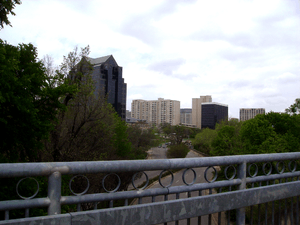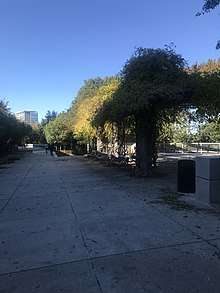Katy Trail (Dallas)
The Katy Trail is a jogging, walking, inline skating, and bicycling path that runs through the Uptown and Oak Lawn areas of Dallas, Texas (USA), following the path of the old Missouri-Kansas-Texas Railroad, which was known as MKT or the Katy.

About
In Dallas, abandoned railroad tracks that had once divided the downtown core are rapidly being transformed into the unifying Katy Trail, a linear 3.5-mile-long (5.6 km), landscaped pedestrian, inline skating and bicycle trail system that runs through the most densely developed section of the city. Construction was started in spring 2000. Several features have already been completed, including the 12-foot-wide (3.7 m) primary trail, two of four new entrance plazas and four of the six planned pedestrian bridges. Construction was completed in 2007 on the Thomsen Overlook plaza, overlooking Reverchon Park. An 8-foot-wide (2.4 m) secondary jogging trail has 1 mile (1.6 km) left of construction, which will be completed once more funding is secured. The work is being carried out by The Friends of Katy Trail under a master plan created by The SWA Group office, in Dallas.[1]

The trail consists of a 12-foot-wide (3.7 m) concrete path[2] for pedestrians and cyclists that runs 3.5 miles (5.6 km)[2] from the American Airlines Center in Victory Park to Mockingbird Station (a DART light rail station) near Southern Methodist University. Next to the concrete path, a parallel soft recycled-rubber track is built for runners.
This adaptive re-use of unused railroad tracks—long a public eyesore and nuisance—unifies several important Dallas districts and provides a major recreational amenity for the more than 300,000 people who live and work within a mile of the trail (the southernmost trailhead is 0.5 miles (800 m) from downtown Dallas at the American Airlines Center). This new, partly completed linear greenway already attracts pedestrians and nature-lovers, both Dallas residents and visitors.
The Katy Trail is also directly responsible for an upsurge in property values and retail-restaurant sales in adjacent neighborhoods and developments. The April 21, 2006, The Dallas Morning News called Katy Trail "one of our city’s favorite outdoor spaces". Katy Trail has become such a popular jogging location that some Dallasites quip, "The trains don’t run here any more...Dallas does."
History
The trail's life began when the Union Pacific Railroad, which had bought the Katy, donated the abandoned lines to the city in 1993. The train tracks that are now the location of the Katy Trail formed the major east-bound route through Dallas of the former Missouri-Kansas-Texas (MKT or "Katy") Railroad, which shut down this segment of its network in the late 1980s. The stations, which had served Dallas residents on their trips east for so many years, were torn down, but the tracks remained.
In the early 1980s The Katy was initially considered for DART's Red and Blue lines to the Northeast, but the current route beneath Central Expressway was chosen instead.
By the early 1990s, Dallas residents, business people, and city and county officials proposed restoring the greenbelt along the railroad route and creating an urban park as part of the national Rails-to-Trails Conservancy program, established in 1986 and based in Washington, D.C.


Initial funding for the project came through Dallas County and state grants. The Friends of the Katy Trail, a nonprofit organization, was founded in 1997 to organize public and private support for development and maintenance of the Katy Trail. Their capital campaign has since raised $11 million from government sources and $12 million from private funding and land donations.
The Katy Trail is intended to provide an effective way of connecting the various Dallas city parks running from White Rock Lake to the Trinity River Project park system along the Trinity River. The rail trail runs alongside Reverchon Park and the parks system along Turtle Creek, a tributary of the Trinity River.
Master plan
Originally, the Dallas Park & Recreation Department planned a basic concrete pathway system along the railroad right of way. The Friends of the Katy Trail have greatly expanded that vision by hiring The SWA Group, an international landscape architecture, planning, and urban design firm, to create a $23 million master plan for two trails and an urban park connecting the West End district to Mockingbird Station.

When completed over the next few years, Katy Trail will have a 3.5-mile-long (5.6 km), 12-foot-wide (3.7 m) concrete path for bicyclists and in-line skaters, an adjacent 3.1-mile-long (5.0 km), 8-foot-wide (2.4 m) soft-surface track for pedestrians, four major entrance plazas, ADA-compliant entrances, benches, landscaping, and drinking fountains for all users, including pets. It will be connected to the Trinity Strand Trail.[3]
The planting plan is dominated by native Texas trees and plants, including chinkapin and Lacey oaks, perennial grasses, Flame Acanthus, and numerous species of native salvias and other plans which support water conservation.
For years, the abandoned railroad tracks had been populated by the homeless, drug dealers, and gangs. The master plan includes strategies to transform negative public perceptions of the Katy Trail through landscaping, lighting, and particularly in the design of nine public spaces at important crossings and intersections. For night-time safety without adding light pollution, reflective shield lamps atop 25-foot (7.6 m) poles direct light onto the trail. The public spaces have more intimate lighting and distinctive light fixtures.
References
- The SWA Group
- Friends of the Katy Trail - Master Plan Archived December 6, 2006, at the Wayback Machine. Retrieved October 15, 2006.
- Wilonsky, Robert (May 10, 2012). "Take a ride on The Connection that will one day link the Katy Trail to the Trinity Strand Trail. At least, that's still the plan". The Dallas Morning News. Archived from the original on May 10, 2012. Retrieved May 11, 2012.